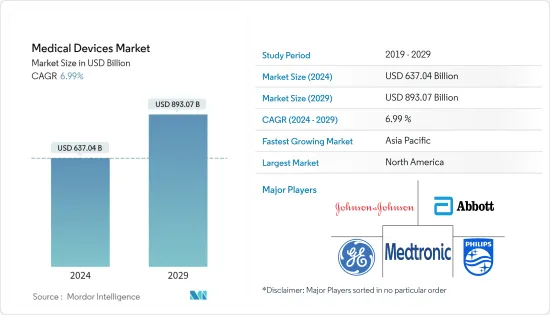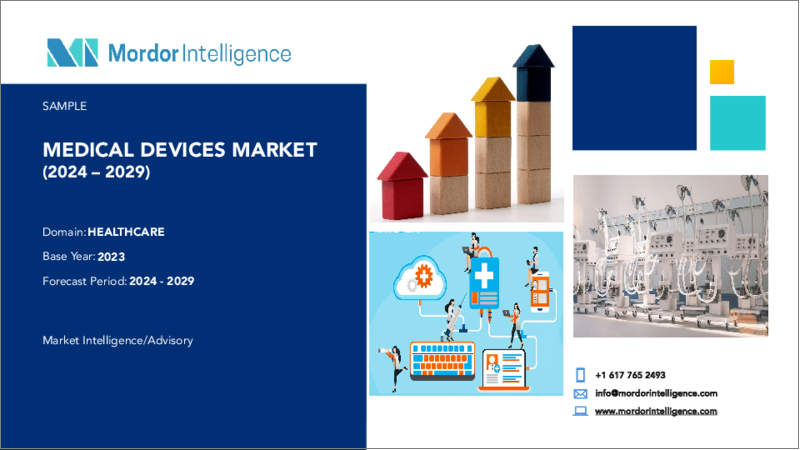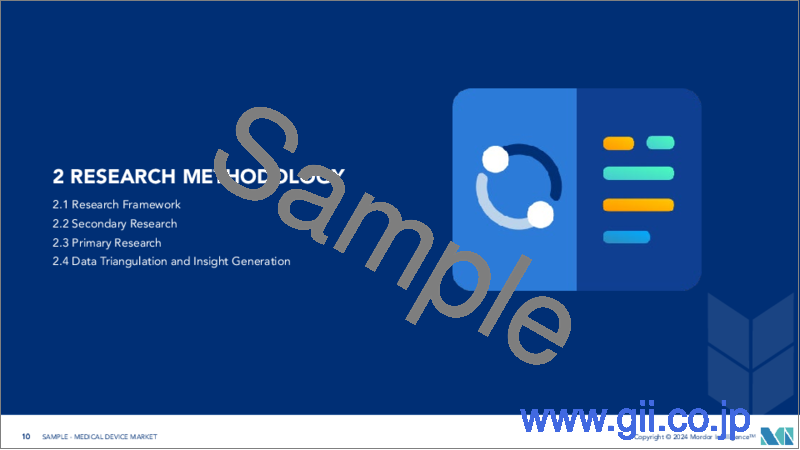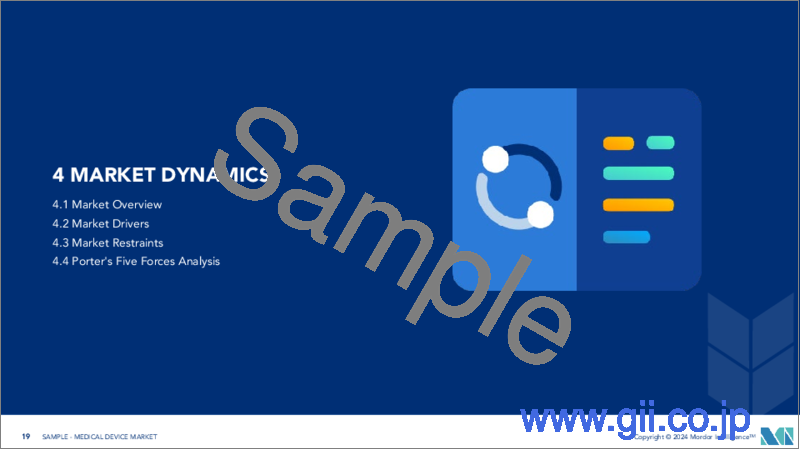|
|
市場調査レポート
商品コード
1441664
医療機器:市場シェア分析、業界動向と統計、成長予測(2024~2029年)Medical Devices - Market Share Analysis, Industry Trends & Statistics, Growth Forecasts (2024 - 2029) |
||||||
|
● お客様のご希望に応じて、既存データの加工や未掲載情報(例:国別セグメント)の追加などの対応が可能です。 詳細はお問い合わせください。 |
|||||||
| 医療機器:市場シェア分析、業界動向と統計、成長予測(2024~2029年) |
|
出版日: 2024年02月15日
発行: Mordor Intelligence
ページ情報: 英文 176 Pages
納期: 2~3営業日
|
- 全表示
- 概要
- 目次
医療機器市場規模は2024年に6,370億4,000万米ドルと推定され、2029年までに8,930億7,000万米ドルに達すると予測されており、予測期間(2024年から2029年)中に6.99%のCAGRで成長します。

COVID-19のパンデミックは医療機器市場全体に深刻な影響を与え、さまざまなセグメントが広範囲にわたる影響を被りました。パンデミックにより、必須ではない手続きや選択的な手続きが延期またはキャンセルされました。たとえば、2022年8月にヘルスケアジャーナルに掲載された「UAEにおける画像診断処置に対するCOVID-19の影響」というタイトルの記事によると、パンデミック中に実施された放射線処置は、COVID-19以前と比べて約80%減少しました。この放射線治療件数の減少により医療機器の需要がさらに減少し、COVID-19パンデミック中の市場の成長に影響を及ぼしました。
しかし、個人用保護具(PPE)、人工呼吸器、一般病院用品など、COVID-19管理のための病院設備を供給する調査対象市場では、圧倒的な需要を満たすために売上が急増しました。たとえば、重篤な状態にあるCOVID-19患者にとって重要な機器である人工呼吸器は、パンデミック中に需要が高まりました。 2020年3月、メドトロニックは人工呼吸器の生産をこれまでに40%以上増加させました。これはパンデミック中の医療機器の成長に影響を与えました。
慢性疾患の有病率の上昇とそれに関連する障害調整生存年数の増加、医療機器の技術進歩、高齢化人口の一貫した増加などの要因が市場の成長を押し上げています。
高齢者は加齢に関連した病気にかかる可能性が高くなりますが、若い人にはあまりかかりません。たとえば、2021年12月に発表された調査研究によると、45歳以上の人の自己申告による心血管疾患(CVD)の有病率は全体で29.4%でした。同じ情報源によると、この有病率は年齢とともに増加し、45~54歳のグループでは22%から70歳以上のグループでは38%となり、高齢者集団がCVDを発症するリスクが高いことを示しています。この発見により、心臓手術や心臓の状態を定期的に監視するのに役立つデバイスの需要が増加し、それによって市場の成長が促進されると予想されます。
さらに、世界中で慢性疾患の負担が増大しているため、さまざまな診断や外科的処置を伴う効果的で高度な治療サービスの需要が高まっています。したがって、世界中で医療機器の需要が増加しています。たとえば、IDFが発行した2022年の統計によると、2021年にはカナダでは約290万人が糖尿病を抱えて暮らしていました。さらに、同じ情報源によると、この数は2030年までに320万人、2045年までに340万人に達すると予測されています。したがって、糖尿病患者数の予想される増加により、状態を定期的に監視するためのさまざまなウェアラブルおよびポータブル医療機器の需要が高まる可能性があります。
さらに、技術的に高度な医療機器の開発と製品発売の増加への注目の高まりも市場の成長に貢献しています。たとえば、マックスベンチレーターは2022年 5月に、酸素療法と加湿器を内蔵した多機能非侵襲的人工呼吸器をインドで発売しました。また、2022年 4月に、Medline UNITEは、踵骨骨折プレーティングシステムとIM腓骨インプラントを発売しました。今回の発売により、プレートとネジ固定によるORIFを必要とするほぼすべての骨折に対応する、包括的なチタン製の足と足首の外傷システムが提供されます。
ただし、厳格な規制と償還の不確実性により、予測期間中の医療機器市場の成長が妨げられる可能性があります。
医療機器市場動向
心臓用セグメントは、予測期間中に医療機器市場で主要なシェアを保持すると予想される
心臓用セグメントは、心血管疾患の有病率の上昇、主要な市場プレーヤーによる戦略的取り組み、心臓病機器の技術進歩などの要因により、予測期間中に医療機器市場が大幅に成長すると予想されています。
さらに、肥満、糖尿病、高血圧、高コレステロールの発生率と有病率の増加も、これらの疾患に苦しむ患者は一生のうちに心臓合併症を発症する可能性が高いため、心臓用医療機器の需要に寄与しています。
心臓血管用デバイスは、心臓病の診断や関連する健康上の問題の治療に使用されます。心臓病学で使用される機器は、外科用、治療用、診断用の3つのカテゴリに分類されます。広く使用されている心臓血管装置には、心電図(ECG)、除細動器、ペースメーカー、心調律管理装置、カテーテル、グラフト、心臓弁、ステントなどがあります。
心血管疾患に苦しむ人の数の増加が、医療機器の需要を促進する主な要因です。たとえば、CDCが発表した2021年のデータによれば、米国では毎年80万5,000人が心臓発作を起こしており、そのうち60万5,000人が初めての心臓発作であり、20万人は以前の心臓発作が原因であることが観察されています。さらに、米国心臓協会が発行した2021年の統計によると、2035年までに米国の成人 1億3,000万人以上が何らかの心臓病を患うと推定されています。
さらに、企業活動の成長と技術の進歩(心臓ウェアラブルデバイスでの人工知能の使用など)により、心臓用デバイスで管理される患者の数が増加し、その結果、治療およびモニタリングの成果が飛躍的に向上しました。これにより、予測期間中に調査対象セグメントの成長が増加すると予想されます。たとえば、トランスルミナは2022年4月に、VIVO ISARという名前のデュアルドラッグポリマーフリーコーティングステントを欧州市場で発売しました。また、2021年6月にメドトロニックは、低侵襲アプローチで房室(AV)ブロック患者に高度なペーシング技術を提供する小型の完全内蔵型ペースメーカーであるMicra AVを発売しました。このデバイスは、心臓の上部室内にリードやデバイスを使用せずに心房活動を感知できます。
したがって、前述の要因により、このセグメントは予測期間中に成長すると予想されます。
北米が市場を独占し、予測期間中も成長傾向が続くと予想される
北米は、慢性疾患の負担の増大、高額な医療費、主要企業の存在などの要因により、予測期間にわたって医療機器市場を独占すると予想されています。
さらに、高齢者人口の増加により、予測期間中に市場の成長が高まる可能性があります。たとえば、国連人口基金が発表した2022年の統計によると、カナダでは、人口の大部分が15歳から64歳までの年齢であると推定されており、今年の総人口の65%を占めています。さらに、同じ情報源によると、カナダでは2022年には人口の19%が65歳以上になります。したがって、高齢者人口が増加すると、心肺疾患、呼吸器疾患、整形外科疾患などの慢性疾患を発症しやすくなり、外科的処置だけでなく画像診断の需要も増加します。これにより、医療機器の成長が促進され、予測期間中の市場の成長が促進されると予想されます。
人口における心血管疾患、冠状動脈性心疾患、脳卒中などの慢性疾患の有病率の上昇、および急性呼吸症候群などの呼吸器疾患の増加により、心肺バイパス処置の増加につながり、その結果、医療機器の需要が増加しています。たとえば、米国心臓協会(AHA)が発表した2022年の統計によると、2021年の米国の心不全有病率は600万人で、これは総人口の1.8%に相当します。したがって、国内の心不全症例の負担が大きいため、より良い診断と治療のための医療機器の需要が増加すると予想され、それが予測期間中に市場の成長をさらに促進すると予想されます。
同様に、Cardiovascular Diabetologyが2021年 6月に発表した調査研究によると、身体活動不足が31%増加すると、II型糖尿病(27,100人)、冠状動脈性心疾患(10,300人)、脳卒中の症例数が増加することが観察されました。(2,200人)、心筋梗塞(1,500人)、脳卒中による死亡(400人)、冠状動脈性心疾患による死亡(350人)。したがって、運動不足につながるライフスタイルの変化は心臓病のリスクをさらに高める可能性があり、患者の閉塞した動脈を開くための心臓手術の増加により医療機器の需要が増加し、それによって市場の成長を促進すると予想されます。
さらに、企業が高度な製品の開発や、市場での地位を留保するためのコラボレーションや買収などのさまざまなビジネス戦略の採用にますます注力していることも、市場の成長に貢献しています。たとえば、2022年 3月に、米国に拠点を置く呼吸器ヘルスケア技術企業であるRespira Labsは、音響共鳴を利用して肺機能を評価し、肺空気量の変動を特定するAI搭載のウェアラブル肺モニターであるSylveeをリリースしました。慢性閉塞性肺疾患(COPD)、喘息、COVID-19の早期発見と治療に役立ちます。
さらに、2021年1月、PENTAX MedicalはCapsoVision, Inc.と提携してカナダ保健省のライセンシングCapsoCam Plusビデオカプセルシステムの可用性を拡大しました。この製品拡張により、COVID-19の流行下でもCapsoCam Plus小腸カプセル内視鏡を在宅で管理できるようになりました。パンデミックを適格な患者に提供し、完全にリモートのカプセル内視鏡処置を可能にし、臨床医と患者の間の対面でのやり取りの必要性を効果的に排除します。
したがって、前述の要因により、市場は予測期間中に成長すると予想されます。
医療機器技術業界の概要
医療機器市場は競争が激しく、いくつかの主要企業で構成されています。
その他の特典
- エクセル形式の市場予測(ME)シート
- 3か月のアナリストサポート
目次
第1章 イントロダクション
- 調査の前提条件と市場の定義
- 調査範囲
第2章 調査手法
第3章 エグゼクティブサマリー
第4章 市場力学
- 市場概要
- 市場促進要因
- 世界中で高齢者人口が増加
- 慢性疾患有病率の上昇とそれに関連する障害調整生存年数の増加
- 市場抑制要因
- 厳格な規制方針と償還の不確実性
- ポーターのファイブフォース分析
- 新規参入業者の脅威
- 買い手の交渉力
- 供給企業の交渉力
- 代替製品の脅威
- 競争企業間の敵対関係の激しさ
第5章 市場セグメンテーション
- デバイスの種類別
- 呼吸器用
- 心臓用
- 整形外科用
- 画像診断用(放射線科)
- 内視鏡用
- 眼科用
- その他
- 地域
- 北米
- 米国
- カナダ
- メキシコ
- 欧州
- ドイツ
- 英国
- フランス
- イタリア
- スペイン
- その他欧州
- アジア太平洋
- 中国
- 日本
- インド
- オーストラリア
- 韓国
- その他アジア太平洋
- 中東とアフリカ
- GCC
- 南アフリカ
- その他中東とアフリカ
- 南米
- ブラジル
- アルゼンチン
- その他南米
- 北米
第6章 競合情勢
- 企業プロファイル
- Abbott Laboratories Inc
- Boston Scientific Corporation
- F. Hoffmann-La Roche Ltd
- GE Healthcare(General Electric Company)
- Johnson &Johnson
- Medtronic PLC
- Koninklinje Philips NV
- Siemens Healthineers(Siemens AG)
- Smith &Nephew PLC
- Stryker Corporation
- Fresenius Medical Care AG &Co. KGaA
- 3M Company
- Cardinal Health Inc.
第7章 市場機会と将来の動向
The Medical Devices Market size is estimated at USD 637.04 billion in 2024, and is expected to reach USD 893.07 billion by 2029, growing at a CAGR of 6.99% during the forecast period (2024-2029).

The COVID-19 pandemic severely impacted the overall medical devices market, with the various segments experiencing wide-ranging effects. The pandemic resulted in postponements and cancellations of non-essential and elective procedures. For instance, as per an article published in a healthcare journal in August 2022, titled "COVID-19 impact on diagnostic imaging procedures in UAE," there were around 80% fewer radiological procedures performed during the pandemic compared to pre-COVID times. This declining number of radiological procedures further decreased the demand for medical devices, which affected the market's growth during the COVID-19 pandemic.
However, the studied market supplying hospital equipment for the management of COVID-19, such as personal protective equipment (PPE), ventilators, and general hospital supplies, experienced a surge in sales to fulfill the overwhelming demand. For instance, ventilators, an important equipment for COVID-19 patients in critical conditions, were in high demand during the pandemic. In March 2020, Medtronic increased the production of ventilators by more than 40% to date. This impacted the growth of medical devices during the pandemic.
Factors such as the rising prevalence of chronic and related increases in disability-adjusted life years, technological advancements in medical devices, and a consistent increase in the aging population are boosting market growth.
The geriatric population is more likely to acquire age-related diseases that are less prevalent among younger people. For instance, as per a research study published in December 2021, the overall self-reported prevalence of diagnosed cardiovascular diseases (CVDs) in people aged 45 years and above was 29.4%. As per the same source, this prevalence rate increased with age, from 22% in the 45-54 age group to 38% in the 70+ age group, indicating that the geriatric population is at high risk of developing CVDs. This finding is expected to increase the demand for cardiac surgeries and devices that help in regularly monitoring heart conditions, thereby propelling the market's growth.
Additionally, the increasing burden of chronic diseases worldwide is driving the demand for effective and advanced treatment services that involve various diagnostic and surgical procedures. Thus, the demand for medical devices across the world is increasing. For instance, according to 2022 statistics published by IDF, about 2.9 million people were living with diabetes in Canada in 2021. In addition, as per the same source, this number is projected to reach 3.2 million and 3.4 million by 2030 and 2045, respectively. Thus, the expected increase in the number of people who have diabetes may propel the demand for various wearable and portable medical devices to regularly monitor the condition.
Moreover, the rising focus on developing technologically advanced medical devices and increasing product launches are also contributing to the market growth. For instance, in May 2022, Max ventilator launched multifunctional noninvasive ventilators, which come with inbuild oxygen therapy and humidifier, in India. Also, in April 2022, Medline UNITE launched Calcaneal Fracture Plating System and IM Fibula Implant. The launch provides a comprehensive titanium foot and ankle trauma system to address nearly all fractures requiring ORIF with plate and screw fixation.
However, strict regulations and uncertainty in reimbursement are likely to impede the growth of the medical devices market over the forecast period.
Medical Device Technologies Market Trends
Cardiology Devices Segment is Expected to Hold a Major Share in the Medical Device Market Over the Forecast Period
The cardiology segment is expected to witness significant growth in the medical devices market over the forecast period owing to factors such as the rising prevalence of cardiovascular diseases, strategic initiatives by key market players, and technological advancement in cardiology devices.
In addition, the increasing incidence and prevalence of obesity, diabetes, hypertension, and high cholesterol are also contributing to the demand for cardiological medical devices, as patients suffering from these diseases are likely to develop cardiac complications in their lifetime.
Cardiovascular devices are used for the diagnosis of heart diseases and the treatment of related health problems. The devices used in cardiology are classified into three categories, namely surgical, therapeutic, and diagnostic. Some of the widely used cardiovascular devices are electrocardiograms (ECG), defibrillators, pacemakers, cardiac rhythm management devices, catheters, grafts, heart valves, and stents.
The growing number of people suffering from cardiovascular diseases is the key factor driving the demand for medical devices. For instance, as per the 2021 data published by CDC, it has been observed that every year, 805,000 people in the United States have a heart attack, 605,000 of these result in a first-time heart attack, while 200,000 are caused by previous heart attacks in 2020. Additionally, according to 2021 statistics published by the American Heart Association, it was estimated that by the year 2035, more than 130 million adults in the United States will have some type of heart disease.
Moreover, growth in company activities and increasing technological advancements (such as the use of artificial intelligence in cardiac wearable devices) have led to an increasing number of patients being managed with cardiology devices, resulting in exponential therapeutical and monitoring outcomes. This is expected to increase the growth of the studied segment over the forecast period. For instance, in April 2022, Translumina launched its Dual Drug Polymer-Free Coated Stent named VIVO ISAR in the European market. Also, in June 2021, Medtronic launched Micra AV, a miniaturized, fully self-contained pacemaker that delivers advanced pacing technology to atrioventricular (AV) block patients via a minimally invasive approach. The device can sense atrial activity without a lead or device in the upper chamber of the heart.
Therefore, owing to the aforesaid factors, the segment is expected to witness growth over the forecast period.
North America Dominates the Market and is Expected to Continue the Growth Trend During the Forecast Period
North America is expected to dominate the medical devices market over the forecast period owing to the factors such as the growing burden of chronic diseases, high healthcare expenditures, and the presence of key players.
In addition, the increasing geriatric population is likely to increase the market growth over the forecast period. For instance, according to the 2022 statistics published by the United Nations Population Fund, in Canada, a large proportion of the population is estimated to be aged between 15 and 64 years and accounts for 65% of the total population in the current year. In addition, as per the same source, 19% of the population is aged 65 years and above in 2022 in Canada. Thus, the rising geriatric population is more prone to develop chronic diseases such as cardiopulmonary diseases, respiratory diseases, and orthopedic disorders, which increase the demand for diagnostic imaging as well as surgical procedures; this, in turn, is anticipated to fuel the growth of the medical devices, thereby propelling the market growth over the forecast period.
The rising prevalence of chronic diseases such as cardiovascular diseases, coronary heart diseases, stroke, and rising respiratory diseases such as acute respiratory syndrome among the population, leads to increased cardiopulmonary bypass procedures, resulting in an increasing demand for medical devices. For instance, according to 2022 statistics published by American Heart Association (AHA), the prevalence rate of heart failure in the United States in 2021 was 6 million, which is 1.8% of the total population. Thus, the high burden of cases of heart failure in the country is expected to increase the demand for medical devices for better diagnosis and treatment, which is further expected to boost the growth of the market over the forecast period.
Similarly, from a research study published by Cardiovascular Diabetology in June 2021, it was observed that a 31% increase in physical inactivity resulted in an increase in the number of cases of Type II diabetes (27,100), coronary heart disease (10,300), stroke (2200), myocardial infarction (1500), stroke deaths (400), and coronary heart disease deaths (350). Thus, changing lifestyles leading to physical inactivity can further increase the risk of heart disease, which is expected to increase the demand for medical devices due to increased heart surgeries to open the blocked arteries in patients, thereby boosting market growth.
Furthermore, the growing focus of companies on developing advanced products and adopting various business strategies, such as collaborations and acquisitions to withhold their market position, is also contributing to the market growth. For instance, in March 2022, Respira Labs, a respiratory healthcare tech business based in the United States, released Sylvee, an AI-powered wearable lung monitor that employs acoustic resonance to assess lung function and identify variations in lung air volume. It can aid in the early detection and treatment of chronic obstructive pulmonary disease (COPD), asthma, and COVID-19.
Moreover, in January 2021, PENTAX Medical increased the availability of the CapsoCam Plus video capsule system with Health Canada licensing in partnership with CapsoVision, Inc. This product expansion enables at-home administration of the CapsoCam Plus small bowel capsule endoscope during the COVID-19 pandemic for eligible patients, permitting a fully remote capsule endoscopy procedure and effectively eliminating the need for in-person interactions between clinicians and their patients.
Therefore, owing to the aforesaid factors, the market is expected to witness growth over the forecast period.
Medical Device Technologies Industry Overview
The medical devices market is competitive and consists of several major players. Companies like Abbott Laboratories Inc, F. Hoffmann-La Roche Ltd, Philips Healthcare, Siemens Healthineers (Siemens AG), Stryker Corporation, Boston Scientific Corporation, Johnson & Johnson, Medtronic PLC, Smith & Nephew PLC, and GE Healthcare hold substantial shares in the market.
Additional Benefits:
- The market estimate (ME) sheet in Excel format
- 3 months of analyst support
TABLE OF CONTENTS
1 INTRODUCTION
- 1.1 Study Assumptions and Market Definition
- 1.2 Scope of the Study
2 RESEARCH METHODOLOGY
3 EXECUTIVE SUMMARY
4 MARKET DYNAMICS
- 4.1 Market Overview
- 4.2 Market Drivers
- 4.2.1 Growing Geriatric Population Across the World
- 4.2.2 Rising Prevalence of Chronic Diseases and Related Increase in Disability-adjusted Life Years
- 4.3 Market Restraints
- 4.3.1 Strict Regulatory Polices and Uncertainty in Reimbursement
- 4.4 Porter's Five Forces Analysis
- 4.4.1 Threat of New Entrants
- 4.4.2 Bargaining Power of Buyers/Consumers
- 4.4.3 Bargaining Power of Suppliers
- 4.4.4 Threat of Substitute Products
- 4.4.5 Intensity of Competitive Rivalry
5 MARKET SEGMENTATION (Market Size by Value - USD million)
- 5.1 By Type of Device
- 5.1.1 Respiratory Devices
- 5.1.2 Cardiology Devices
- 5.1.3 Orthopedic Devices
- 5.1.4 Diagnostic Imaging Devices (Radiology Devices)
- 5.1.5 Endoscopy Devices
- 5.1.6 Ophthalmology Devices
- 5.1.7 Other Devices
- 5.2 Geography
- 5.2.1 North America
- 5.2.1.1 United States
- 5.2.1.2 Canada
- 5.2.1.3 Mexico
- 5.2.2 Europe
- 5.2.2.1 Germany
- 5.2.2.2 United Kingdom
- 5.2.2.3 France
- 5.2.2.4 Italy
- 5.2.2.5 Spain
- 5.2.2.6 Rest of Europe
- 5.2.3 Asia-Pacific
- 5.2.3.1 China
- 5.2.3.2 Japan
- 5.2.3.3 India
- 5.2.3.4 Australia
- 5.2.3.5 South Korea
- 5.2.3.6 Rest of Asia-Pacific
- 5.2.4 Middle East & Africa
- 5.2.4.1 GCC
- 5.2.4.2 South Africa
- 5.2.4.3 Rest of Middle East & Africa
- 5.2.5 South America
- 5.2.5.1 Brazil
- 5.2.5.2 Argentina
- 5.2.5.3 Rest of South America
- 5.2.1 North America
6 COMPETITIVE LANDSCAPE
- 6.1 Company Profiles
- 6.1.1 Abbott Laboratories Inc
- 6.1.2 Boston Scientific Corporation
- 6.1.3 F. Hoffmann-La Roche Ltd
- 6.1.4 GE Healthcare (General Electric Company)
- 6.1.5 Johnson & Johnson
- 6.1.6 Medtronic PLC
- 6.1.7 Koninklinje Philips NV
- 6.1.8 Siemens Healthineers (Siemens AG)
- 6.1.9 Smith & Nephew PLC
- 6.1.10 Stryker Corporation
- 6.1.11 Fresenius Medical Care AG & Co. KGaA
- 6.1.12 3M Company
- 6.1.13 Cardinal Health Inc.




